| dc.description.abstract | Sorghum downy mildew (SDM), caused by Peronosclerospora sorghi, remains one of the primary constraints to sorghum production worldwide. Due to the fastidious nature of the pathogen, in particular the soilborne oospores, which form the major source of inoculum in most sorghum producing countries, studies of the basic biology of P. sorghi remain few. This study attempts to explore the environmental aspects affecting the incidence of SDM as well as expand the base of knowledge regarding the resistant reaction of sorghum seedling roots to infection by oospores of P. sorghi. Soil moisture is an important environmental factor that affects soilborne plant pathogen. Soil moisture is often considered as the ability of the soil to release water, or matric potential (ψm). In this study the effect of ψm on the incidence of SDM was tested using the Haines pressure plate apparatus to control and maintain it. From the conditions tested in two soil types, a lower soil moisture of -33 kilo Pascales (kPa) was shown to be the most conducive condition for disease development as well as oospore germination when compared to the -20 (intermediate) and 0.0 (saturation) kPa. Previous studies have suggested the use of bait crops to induce oospores, which must encounter a compatible host to survive, to germinate and therefore reduce inoculum potential in the field. This hypothesis was tested in a single field naturally infested with oospores of P. sorghi using seven different bait crops. In all treatments the incidence of SDM was significantly reduced compared to the fallow control.
A microscopic study of the infection structure and defense response of sorghum seedling against P. sorghi oospore derived germtubes remains largely undocumented. Roots of resistant and susceptible sorghum seedlings were inoculated with oospores and the stages of development were observed using fluorescence microscopy. In a separate experiment, the activity of plant defense-related enzymes in sorghum seedling roots inoculated with oospores was measured. Significantly increased activity levels of glucanase, peroxidase, and phenylalanine ammonia lyase were found in inoculated roots compared to untreated controls and compatible interactions. However, chitinase activity levels were similar among all treatments. | en |


